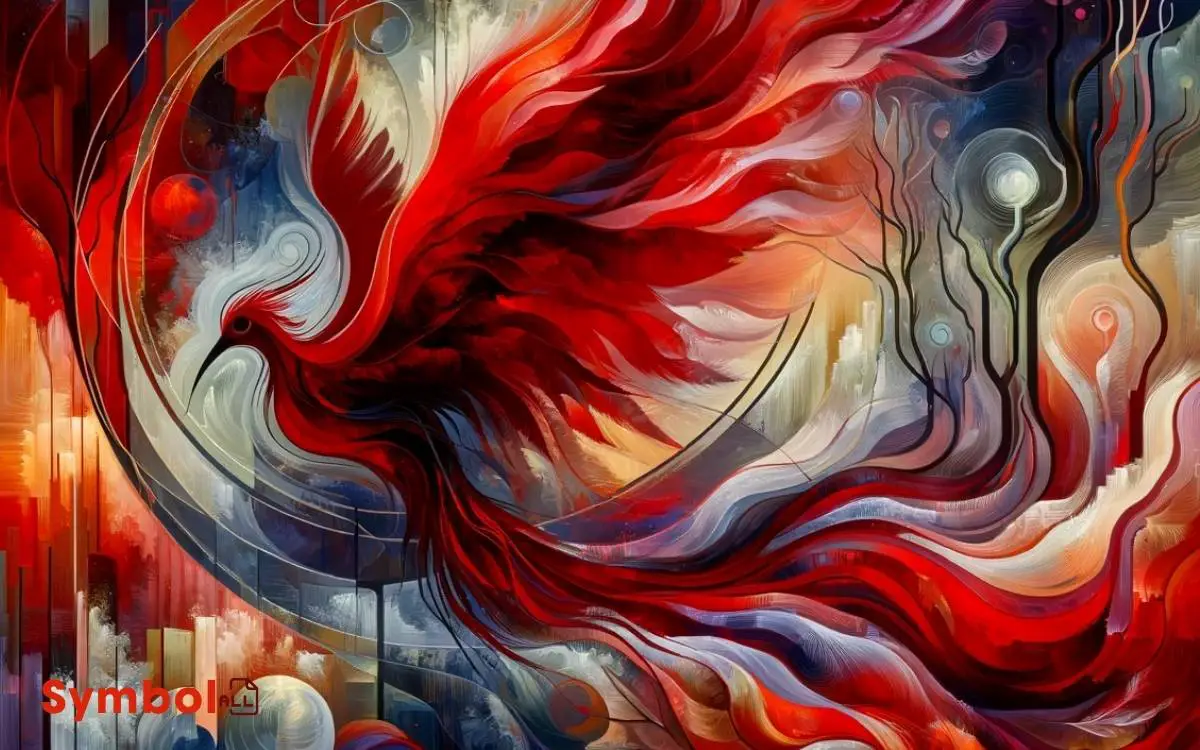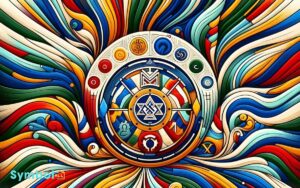What Does the Color Red Symbolize in the Scarlet Ibis? Explain!
In “The Scarlet Ibis,” the color red symbolizes a deep tapestry of emotions and themes, from passion and danger to the very essence of life and death.
It’s a deliberate choice by the author to enrich the narrative, offering you a gateway into the complex emotions and themes within the story. Red embodies the lifeblood of the characters, reflecting their love, suffering, and the inevitable cycles of life and death.
It’s intertwined with the dynamics of family, the pressures of societal expectations, and the profound acts of love and sacrifice.
As you explore further, you’ll uncover how red transcends its visual presence, deepening your understanding of the characters and their relationships, revealing the story’s rich emotional and philosophical layers.

Key Takeaways
The Essence of Red
The color red, often associated with passion, danger, and essentiality, serves as a multifaceted symbol in ‘The Scarlet Ibis,’ reflecting the complex emotions and themes intertwined throughout the narrative.
You’ll notice it’s not merely a backdrop but actively participates in shaping the story’s emotional landscape. Red embodies the lifeblood of the characters, marking moments of intense feeling and pivotal changes.
It’s in the scarlet ibis itself, a bird that symbolizes the fragility of life and the inevitability of death, casting a poignant hue over the story’s events.
This color’s presence isn’t accidental; it’s a deliberate choice by the author to weave a deeper understanding of the characters’ inner worlds and the inevitable outcomes of their actions.
Through red, you’re invited to explore the depths of human emotion, witnessing its power to both animate and destroy.
Brotherhood and Sacrifice
In examining the symbolism of red within ‘The Scarlet Ibis,’ you encounter the complex layers of brotherhood and sacrifice.
The color red weaves through familial bonds, highlighting the depth of relationships and the ultimate acts of love that define them.
This analysis reveals how red serves not only as a motif but also as a poignant metaphor for the sacrifices inherent in true brotherhood.
Familial Bonds Explored
Exploring the depths of brotherhood and sacrifice, ‘The Scarlet Ibis’ intricately weaves these themes into its narrative fabric, showcasing how familial bonds can both uplift and devastate.
You’re drawn into the complex dynamics between the narrator and his brother, Doodle, witnessing the dual nature of love and expectation within a family.
This relationship, laden with the desire for normalcy and acceptance, underscores the sacrifices made in the name of familial love.
The story meticulously dissects the pressures of societal norms on family relationships, revealing how the pursuit of idealistic goals can strain or even harm the very bonds it aims to strengthen.
Through ‘The Scarlet Ibis’, you’re invited to reflect on the true cost of expectations and the nuanced layers of brotherhood and sacrifice.
Ultimate Acts of Love
Reflecting on the narrative of ‘The Scarlet Ibis’, you’ll find that acts of ultimate love, manifesting as brotherhood and sacrifice, underscore the story’s emotional core.
This poignant theme is intricately woven through:
- The narrator’s complex feelings of pride and guilt.
- His relentless efforts to teach Doodle how to walk.
- The bittersweet triumphs and devastating setbacks they experience together.
- The ultimate sacrifice of Doodle, symbolized by the scarlet ibis itself.
- The narrator’s profound realization of his deep love for Doodle, albeit too late.
These elements collectively depict a narrative rich in the exploration of the human condition, emphasizing that true love often involves selflessness and sacrifice.
Through brotherhood, the story reveals the multifaceted nature of love, marked by both its capacity to uplift and its potential for sorrow.
Foreboding and Doom
The color red, symbolizing both life and death, ominously foreshadows doom and foreboding in ‘The Scarlet Ibis.’ As you explore further into the narrative, you’ll encounter instances where red not only marks significant turning points but also hints at the impending tragedy.
The vivid imagery of the scarlet ibis, a bird distinctly out of place, echoes the protagonist’s own sense of alienation and the inevitable fate that awaits. This bird, with its striking red plumage, becomes a harbinger of loss, its death prefiguring the story’s heartbreaking conclusion.
Similarly, red references throughout the text, from the sunset to the bleeding tree, subtly build a sense of unease. They serve as visual cues, preparing you for the narrative’s climax, underscoring the inevitability of loss and the fragility of life.
Loves Deep Shades
As you explore ‘Loves Deep Shades‘, consider how the symbolism of deep red weaves through the narrative, embodying both passion and peril.
The emotional resonance of this hue reflects the complexity of human relationships, hinting at love’s profound depths and its potential for tragedy.
Nature’s red signals, from the scarlet ibis itself to the crimson sunsets, further enrich this tapestry, offering a poignant reminder of the cycles of life and death.
Symbolism of Deep Red
In literature, deep red often symbolizes intense emotions such as love or passion, revealing characters’ deepest feelings and connections. This vivid hue serves multiple layers of meaning, extending its symbolism beyond the surface.
- Conflict and danger: Deep red can indicate impending doom or the presence of a significant challenge, underscoring the stakes involved.
- Sacrifice: It often represents the ultimate sacrifice, hinting at a character’s willingness to give everything for their beliefs or loved ones.
- Metamorphosis: This color marks a shift or change, signaling a character’s growth or downfall.
- Power: It embodies power and authority, illustrating characters’ control or their desire to attain it.
- Forbidden love: Deep red may suggest a love that defies norms, highlighting its intensity and the risks associated with it.
Emotional Resonance
Exploring deeper, we find that deep red’s emotional resonance extends beyond mere symbolism, offering a nuanced palette where loves deep shades evoke profound connections and responses.
This color, rich and vibrant, taps into the very essence of human emotion, acting as a conduit for expressing the deepest affections and the most fervent passions. This shade carries with it an undeniable energy, evoking a spectrum of feelings that range from warmth and tenderness to bold intensity. It transcends mere aesthetics, delving into cultural and personal symbolism to reveal layers of meaning. At its core, what the color pink represents is a unique blend of love, compassion, and an unabashed celebration of life’s more vulnerable and heartfelt moments.
In literature, deep red often embodies the intensity of characters’ emotions, from love’s first flush to the burning coals of enduring affection. It’s not merely a color but a symbol of the heart’s capacity to feel deeply and passionately.
Analyzing its use in ‘The Scarlet Ibis,’ we see how deep red not only colors the narrative but also enriches it, layering the story with emotional depth and complexity, thereby enhancing the reader’s engagement and empathy.
Natures Red Signals
Nature’s palette, particularly its use of the color red, sends powerful signals of love and danger, intertwining these seemingly disparate themes with the intricacies of human emotion and survival.
You’ll find that red serves as a vivid messenger in the natural world, through:
- Roses and tulips, symbolizing deep love and passion.
- The striking plumage of the cardinal, a beacon of vitality and energy.
- Warning colors of poisonous berries and frogs, signaling potential harm.
- Sunsets and sunrises, marking changes and the promise of new beginnings.
- The flush of human cheeks, often a sign of emotion—ranging from embarrassment to attraction.
Through these examples, it’s evident how deeply interwoven the color red is with the fabric of life, embodying both the danger and beauty of existence.
Pride and Its Pitfalls
Pride, while often seen as a driving force behind achievement, can also lead to devastating consequences, as evidenced by the complex dynamics within ‘The Scarlet Ibis.’
You’ll find that the narrative intricately weaves this theme, showing how pride can blind one to the value of compassion and humanity.
The protagonist’s pride in his brother’s accomplishments overshadows the genuine care and understanding that should have been the foundation of their relationship.
| Aspect of Pride | Consequence in ‘The Scarlet Ibis’ |
|---|---|
| Desire for acceptance | Leads to unrealistic expectations |
| Fear of shame | Results in neglect of genuine care |
| Obsession with achievement | Culminates in tragic outcomes |
This table underscores the multifaceted nature of pride and its profound impact, urging you to reflect on the delicate balance between ambition and empathy.
The Cycle of Life
You’ll notice that the color red in ‘The Scarlet Ibis’ serves not only as a symbol of death but also as a poignant reminder of birth, embodying nature’s relentless cycle.
This juxtaposition highlights the interconnectedness of life’s beginnings and endings, a theme mirrored in the natural world where the scarlet ibis itself thrives.
Through careful examination, you can discern how this motif offers a deeper understanding of the narrative’s exploration of the fragile, cyclical nature of existence.
Birth and Death
In the ‘Scarlet Ibis,’ the color red serves as a poignant symbol for the intertwined nature of birth and death, illustrating the cyclical journey of life.
This vivid hue encapsulates both the beginning and the culmination of existence, compelling you to reflect on the profound connections between these two stages.
Through this lens, the narrative weaves a rich tapestry of meaning:
- Red signifies the blood of childbirth, a universal symbol of life beginning.
- It mirrors the autumn leaves, hinting at life’s inevitable decline.
- The color embodies the scarlet ibis itself, a creature experiencing its own cycle of life and death.
- It represents the sunset, symbolizing the day’s end and life’s eventual closure.
- Lastly, red is the color of the heart, the seat of life, pulsating from birth until death.
This dual representation underscores the natural progression from existence to cessation, framing life as a journey marked by vibrant beginnings and inevitable ends.
Natures Eternal Flow
The cycle of life, as depicted in ‘The Scarlet Ibis,’ reveals nature’s eternal flow through the seamless changes from birth to death. You’re invited to explore the intricate dance between beginnings and endings, a theme that’s pivotal in understanding the depth of the narrative.
The story masterfully intertwines the fate of the characters with the natural world, suggesting that life’s beauty and tragedy are two sides of the same coin.
| Aspect | Significance |
|---|---|
| Birth | A symbol of hope and new beginnings. |
| Growth | Represents development and change. |
| Decline | Signals approaching end and loss. |
| Death | Marks the end and a return to the earth. |
| Rebirth | Suggests renewal and the cycle continuing. |
In grasping this cycle, you expose the layers of symbolism threaded throughout the narrative, enriching your understanding of the story’s core themes.
Natures Crimson Hues
Why does the color red, as seen in nature’s crimson hues, hold such a profound symbolism in the narrative of ‘The Scarlet Ibis’?
In literature, colors often transcend mere visual descriptions, embodying deeper meanings. The color red in nature is no exception, serving as a powerful symbol in the story.
- Sunsets: The fiery red of the setting sun mirrors the story’s themes of endings and the finality of death.
- Autumn Leaves: They signify change and the impermanence of life, echoing the story’s exploration of loss.
- Blood: Represents life force and, conversely, the mortality that binds all creatures.
- Flowers: Especially red ones, symbolize both love and danger, reflecting the complex emotions in the narrative.
- Fruits: Often depicted as forbidden or sacred, they hint at the forbidden desires and the consequences that follow.
Each element of red in nature artistically underscores the narrative’s exploration of themes such as love, death, and the fragility of life.
Symbols of Frailty
While exploring the narrative of ‘The Scarlet Ibis‘, it becomes evident that symbols of frailty intricately weave through the storyline, mirroring the protagonist’s delicate condition and the inherent vulnerability of human life.
The scarlet ibis itself, with its vivid red plumage, emerges not just as a spectacle of color but as a poignant emblem of fragility. Its unexpected arrival and subsequent demise parallel the protagonist’s struggles and ultimate fate, highlighting the ephemeral nature of existence.
The storm that ushers in the bird’s downfall serves as a metaphor for the unpredictable, often harsh, forces that govern life.
Through these symbols, you’re invited to reflect on the transient beauty of life and the delicate balance that sustains it, underscoring the narrative’s meditation on the themes of mortality and the fragility of the human condition.
The Price of Expectations
In ‘The Scarlet Ibis,’ one’s aspirations often come with unforeseen repercussions, meticulously illustrating how the burden of expectations can profoundly impact human relationships and self-perception.
The tale serves as a poignant reminder of the complexities entwined within the fabric of familial bonds and individual identity, underscored by:
- The inherent desire for acceptance and validation.
- The detrimental effects of imposing one’s ambitions onto another.
- The transformation of love into a conditional sentiment, predicated on achievement.
- The internal conflict between personal aspirations and ethical obligations.
- The ultimate realization that the cost of unrealistic expectations can be irrevocably damaging.
Reds Emotional Spectrum
Delving into the emotional spectrum of red, you’ll uncover a rich tapestry of feelings that range from love and passion to anger and danger, each hue casting a profound impact on the narrative and symbolism within ‘The Scarlet Ibis.’
| Hue of Red | Emotion | Symbolic Meaning in ‘The Scarlet Ibis’ |
|---|---|---|
| Bright Red | Love | The deep bond between the brothers |
| Dark Red | Anger | The frustration and challenges faced |
| Crimson | Danger | The foreboding of tragedy |
In this context, each shade of red intricately weaves into the story’s fabric, offering insights into the characters’ emotions and foreshadowing their fates.
Analyzing these colors allows you to grasp the complex emotional landscape that ‘The Scarlet Ibis’ navigates, highlighting the multifaceted nature of human feelings and the consequences they entail.
The Finality of Death
The color red in ‘The Scarlet Ibis’ also casts a stark light on the inevitability of death, underscoring its finality and the profound impact it has on the narrative’s emotional landscape.
This symbolism is meticulously woven throughout the story, offering a multifaceted exploration of death’s permanence.
- *The scarlet ibis itself:* A vivid emblem of life’s fragility and the abruptness of death.
- *Blood:* Represents the physical reality and violence of death.
- *Red flowers:* Symbolize beauty intertwined with mortality.
- *Sunset:* Suggests the end of life, a closing chapter.
- *Storms:* Foretell chaos and the destructive power of nature, leading to loss.
Through these elements, you’re invited to confront the unyielding truth that death is an inevitable, final force, profoundly shaping human experience and emotion.
Transcending Color Symbolism
While exploring the vivid symbolism of red in ‘The Scarlet Ibis,’ it’s crucial to recognize how color transcends mere aesthetic value, embodying deeper thematic significance within the narrative.
This transcension of color symbolism isn’t just an artful choice but a deliberate narrative device that enriches the story’s emotional and philosophical layers.
Red, often associated with love, danger, and cruciality, becomes a multifaceted symbol reflecting the complex relationship between the brothers, the inevitability of death, and the loss of innocence.
Conclusion
In your journey through the tempestuous seas of ‘The Scarlet Ibis,’ you’ve witnessed how red, in its fiery embrace, captures the essence of life and death itself.
It’s not just a color; it’s the blood that courses with love, pride, and the ultimate sacrifices of brotherhood. This crimson hue holds the universe’s secrets, from the tender whispers of affection to the thunderous roars of doom.
Indeed, red transcends mere symbolism, painting every emotion in strokes so vivid, they pierce the soul, teaching us the harrowing beauty and devastating costs of our deepest desires and fears.






